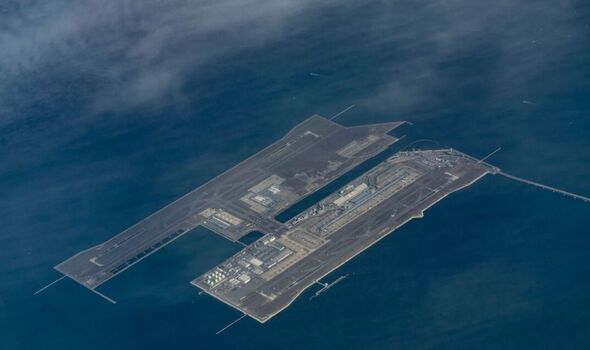A massive £15bn airport hailed as an incredible feat of engineering faces a significant challenge – it’s sinking, and at an alarming rate. Accommodating 30 million travellers a year, Kansai International Airport in Japan celebrated its 30th birthday last year.
Situated on two artificial islands in Osaka Bay, this remote site serves the city of Osaka – Japan’s third-largest city and is connected to the mainland by a 1.9-mile bridge. Opening in 1994, the impressive airport took 20 years to plan and seven years to build.
It was the first airport ever built on reclaimed land in the ocean. In its 30 years, the airport has already built up a long list of accomplishments – it has the longest terminal building in the world spanning 1.7km and amazingly, it has never lost an item of luggage.
The airport can also absorb an earthquake without being damaged, as even the runway is paved with asphalt of concrete which allows it to bend instead of snapping.
The terminal building built by Renzo Piano has a wavelength shape – result of extensive study to bring in cool air so expensive air conditioning does not need to be installed.
In 2001, the American Society of Civil Engineers awarded it the Monument of the Millennium Award along with the Hoover Dam and Golden Gate Bridge.
However, it is facing an unprecedented challenge and it is something that won’t just disappear – it is sinking into the sea.
So far, Kansai has sunk 38 feet, yet remains a crucial hub for airlines like All Nippon Airways, Japan Airlines, and Nippon Cargo Airlines, which operate throughout Asia.
Engineers always knew the seabed would sink a bit as the seabed compacted but in 1990, three years after construction began, they discovered it was sinking much faster than expected by about 5cm a month.
It was initially thought it would sink by 8 metres over the course of 50 years but it sank more than that by the time the airport opened in 1994. Eight years later it had sunk by 12 metres.
In a bid to combat the sinking airport £76m was spent bulking up the island’s height to ensure it didn’t sink below 4 metres above sea level – the height it has to be to avoid being flooded by rough seas.
In a youtube video The B1M says the reason for it sinking is due to the type of clay used.
The Youtuber explained: “Pleistocene is made up of thicker clay and has lots of layers of sand running through it making it very difficult to say how it will react when something this big is put on top of it.
“The rate of settlement has now almost ground to a halt from 50cm a year in 1994 to just 7cm today.”
Despite the rate slowing date the airport was devastated when typhoon Jebi hit in September 2018 which overwhelmed the seawall and flooded the runway, causing a two-week disruption.
In 2019 the seawall was initially raised by 2.2 metres and after this another metre was added to the runway. The wall was then raised by another 2.7 metres to try and prevent such an event occurring again.
And now one of the busiest airports in Asia is getting a £470m renovation to improve its status as a key regional hub and increase capacity.
